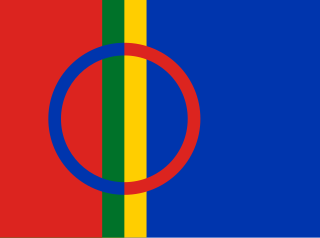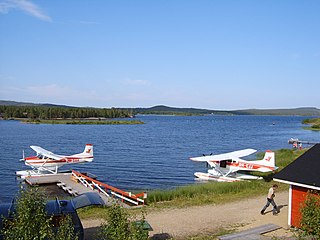Inari Sámi may refer to:
Inari Sámi may refer to:


Lapland is the largest and northernmost region of Finland. The 21 municipalities in the region cooperate in a Regional Council. Lapland borders the region of North Ostrobothnia in the south. It also borders the Gulf of Bothnia, Norrbotten County in Sweden, Troms and Finnmark County in Norway, and Murmansk Oblast and the Republic of Karelia in Russia. Topography varies from vast mires and forests of the South to fells in the North. The Arctic Circle crosses Lapland, so polar phenomena such as the midnight sun and polar night can be viewed in Lapland.
Inari may refer to:

Inari Sámi is a Sámi language spoken by the Inari Sámi of Finland. It has approximately 300 speakers, the majority of whom are middle-aged or older and live in the municipality of Inari. According to the Sámi Parliament of Finland, 269 persons used Inari Sámi as their first language. It is the only Sámi language that is spoken exclusively in Finland. The language is classified as being seriously endangered, as few children learn it; however, more and more children are learning it in language nests. In 2018, Inari Sámi had about 400 speakers; due to revival efforts, the number had increased.
Kemi Sámi was a Sámi language that was originally spoken in the southernmost district of Finnish Lapland as far south as the Sámi siidas around Kuusamo.

Lake Inari is the largest lake in Sápmi and the third-largest lake in Finland. It is located in the northern part of Lapland, north of the Arctic Circle. The lake is 117–119 metres (384–390 ft) above sea level, and is regulated at the Kaitakoski power plant in Russia. The freezing period normally extends from November to early June.

Inari is Finland's largest municipality by area, with four official languages, more than any other in the country. Its major sources of income are tourism, service industry and cold climate testing. With the Siida museum in the village of Inari, it is a center of Sami culture, widely known as the "capital of Sámi culture".

Ivalo is a village in the municipality of Inari, Lapland, Finland, located on the Ivalo River 20 kilometres (12 mi) south of Lake Inari in the Arctic Circle. It has a population of 3,998 as of 2003 and a small airport. 30 kilometres (19 mi) south of Ivalo is a very popular resort named Saariselkä.

"Sleeping Sun" is a power ballad and the fourth single by Finnish symphonic metal band Nightwish. It was released as a maxi single with three other songs on 2 August 1999 to coincide with the total solar eclipse that would occur on 11 August.

Angeli is a village in Lapland. It is 62 kilometres (39 mi) west of village of Inari in the municipality of Inari near the Muotkatunturi Wilderness Area in Finland. The Inari River flows by the village, which is located close to the Norwegian border. Most of the people speak Northern Sámi as their native language.
The Vätsäri Wilderness Area is located along the northeastern shore of Lake Inari in Inari, northern Finland, stretching all the way to the Finland–Norway border. The landscape is dominated by taiga forests of Scots pine, bog and bodies of water. The northeastern part rises as a treeless fell ridge. Vätsäri is one of twelve wilderness areas in Lapland and covers an area of 1,550 square kilometers (600 sq mi). The wilderness has one marked trail and a few cabins. The reserve is under the management of Metsähallitus and was established with the other wilderness reserves in 1991. It is part of Pasvik–Inari Trilateral Park along with Øvre Pasvik National Park and Øvre Pasvik Landscape Protection Area in Norway, and the joint Norwegian–Russian Pasvik Nature Reserve.

The Sámi homeland of Finland is the northernmost part of the Lappi (Lapland) administrative region in Finland, home of approximately half of Finland's Sámi population. The area is defined in and protected by the Finnish constitution to be autonomous on issues relating to the Sámi culture and language.

Inari is a population centre in the municipality by the same name in Lapland, Finland. It is widely known as the capital of Finnish Sámi culture.

Petter Jori Andaras Morottaja is an Inari Sámi who writes books in Inari Sámi. He published his first book at the age of 17. At the age of 25, he ran for the Sámi Parliament of Finland, but was not elected. Actively involved in the Inari Sámi Language Association, he has been named the editor-in-chief of the association's online newspaper Kierâš, which is published once a week. He also teaches Inari Sámi in numerous places, including the University of Helsinki. He is the son of Matti Morottaja and brother of Inari Sami rapper Amoc.

Ukonkivi is located on the island of Ukonsaari in lake Inari, Finnish Lapland. The Inari Sami name for the island is Äijih. The area of the lake is called Ukonselkä. Ukonkivi was considered by the local Inari Sami to be an extremely important sieidi, or sacred natural formation, and was used as a sacrificial site, perhaps as recently as in the 19th century. The names "Ukko" and "Äijih" refer to sky deities in the Finnish and Sami mythologies, respectively.
Kierâš was an Inari Sámi-language online weekly newspaper that was published for the first time on September 6, 2007. It was published by Anarâškielâ servi and its editor-in-chief was Petter Morottaja. At the start, the newspaper was published once a week, offering news, announcements and current topics in Inari Sámi to its readers. The Society for the Promotion of Sámi Culture donated money to cover the costs of running the magazine before the society disbanded in 2007. The Cultural Division of the Sámi Parliament in Finland awarded the newspaper a publication grant for 2008. Kierâš was published for the last time in 2011.

Sámi languages, in English also rendered as Sami and Saami, are a group of Uralic languages spoken by the Sámi people in Northern Europe. There are, depending on the nature and terms of division, ten or more Sami languages. Several spellings have been used for the Sámi languages, including Sámi, Sami, Saami, Saame, Sámic, Samic and Saamic, as well as the exonyms Lappish and Lappic. The last two, along with the term Lapp, are now often considered pejorative.

Inari or Aanaar Sámi are a group of Sámi people who inhabit the area around Lake Inari, Finland. They speak the Inari (Aanaar) Sámi language, which belongs to the eastern Sámi languages. There are an estimated 700–900 ethnic Inari Sámi in Finland, of whom approximately 300–400 speak Inari Sámi. They are the only group of Sámi who live within one state and one municipality. Inari Sámi are indigenous peoples of their area.
Morottaja is a Finnish surname that may refer to